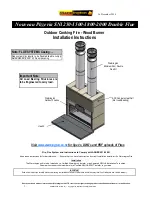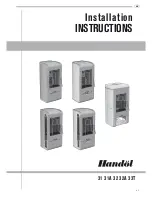
16 December 2014
Due to continued product improvement, Warmington Ind LTD reserves the right to change product specifications without prior notification.
All Dimension are in mm……. Copyright on all products and Specifications ©
2
POINTS TO CONSIDER PRIOR TO INSTALLATION
Location of the fire. Open fires are better located at one end of a room or area, as they project the heat away from their opening.
Venting to the cavity.
This air is to allow the cavity to vent the warm air. This warm air helps keep the fire and flue system form getting to cold. If the flue
and fire get to cold the system may soot often and require cleaning. Each fire has different ways of venting the cavity.
The Topography of the land .
The slope and position of the land in relation to the home has a bearing on how the wind will interact with the fire and flue system.
Care needs to be taken to ensure that the flue termination is in the correct position to maximise performance.
The prevailing wind.
Care needs to be taken to ensure that the flue termination is in the correct position as wind and gusts that hits the flue and cowl
system may overcome the cowl and draft back down the flue into the home. This can be a combination of down draft and high
pressure.
Hearth and plinth:
The height of the hearth off the floor. The finishing that is to be used on the hearth is to be allowed for at the design stage.
Positioning of the Flue system:
There is a maximum distance that an offset flue can be installed. Reference to AS/NZS : 2918
Flue And Fire Clearance:
To be maintained to the manufactures Instructions.
Installation Notes:
A rebate of 40mm is recommended from the front face of the surround to the front of the fire to reduce the ingress of water into
the fire.
Due to the expansion and contraction of metal fireplaces a 3mm gap between the flange and the finished surround should be maintained.
Prior to Construction and Installation Important Notes
:
Install to AS/NZS 2918:2001.
Install to manufacture’s specifications.
All new installations require a permit.
For special requirements concerning materials (timber mantle and surrounds) within close proximity of Warmington products, please contact
your local Warmington Technical Consultant.
Stage 1:
Frame Construction Procedure by Builder.
Mark out flue centre.
Mark out heat cell clearance requirements.
Construct plinth only, to required height. *
Stage 2:
Install Procedure by Certified “Warmington Installer” only.
Fit fire to plinth.
Fit adaptor to Firebox.
Construct ACC enclosure around Nouveau firebox. (Ensure a 40mm rebate to form a drip line).
Fit flue system.
Fit cowl and flashing system
Stage 3:
Finishing Procedure by Builder.
Construct hearth to required thickness. *
Finish ACC enclosure and hearth to customers requirements (e.g. paint / tiles ).
Close in ACC enclose and chimney chase . ( If in timber Alcove ).
* Note: certified installer can install hearth and plinth.
Ensure that the Warmington and flue system is swept annually or more frequently if required.
To sweep flue and firebox:
Cover front of fire with sheets.
Remove cowl from top of chimney.
Sweep from the top, down the flue.
Remove all soot and ash.
Ensure cowl and bird protection is clean and replaced.
Visually inspect fireplace and flue system.
INSTALLATION ORDER OF OPERATIONS

































